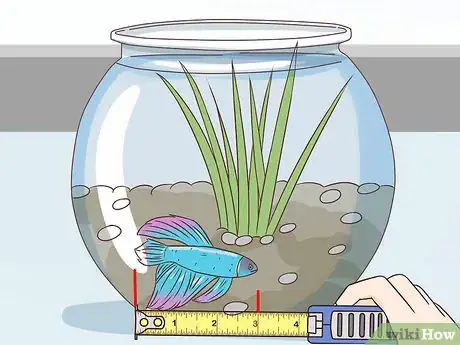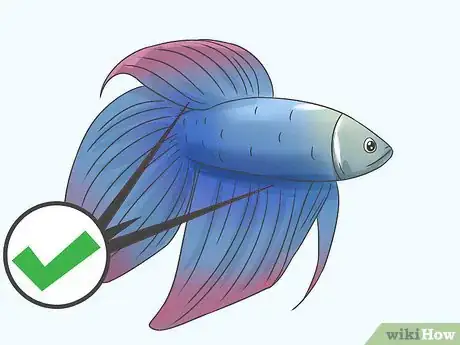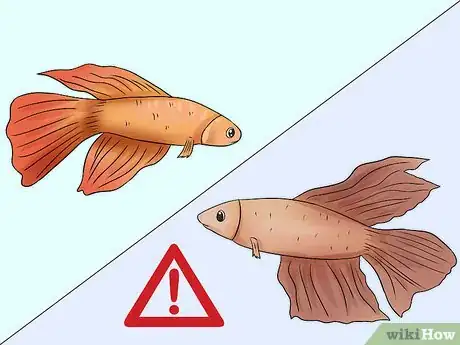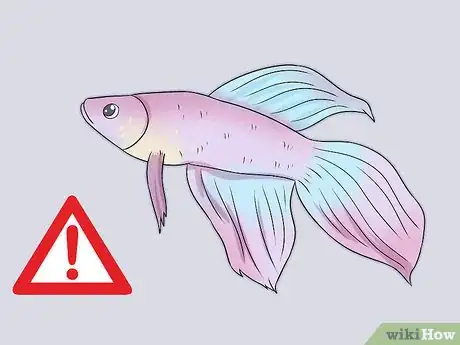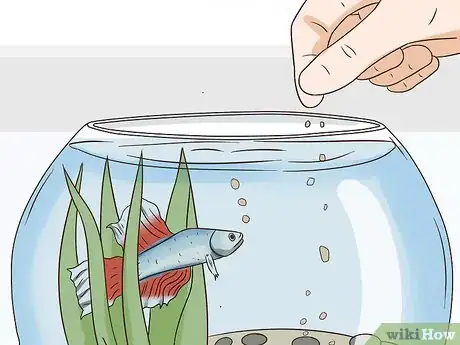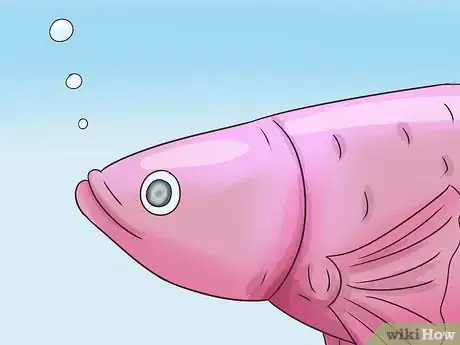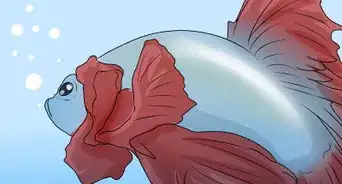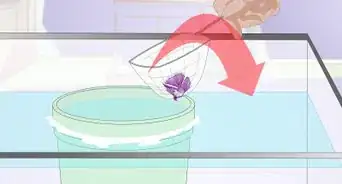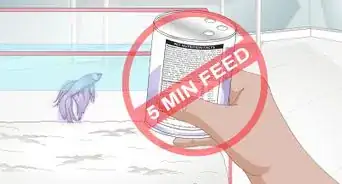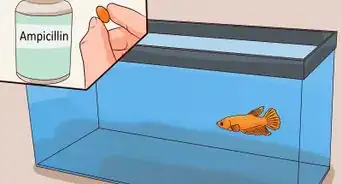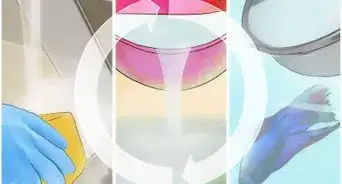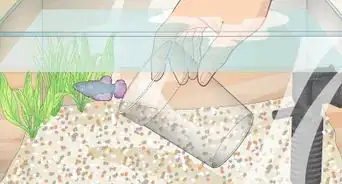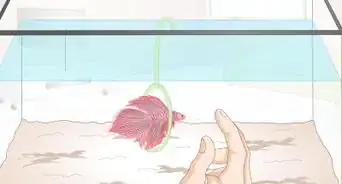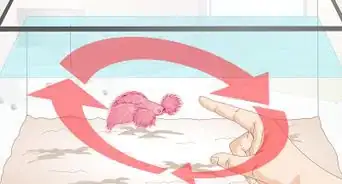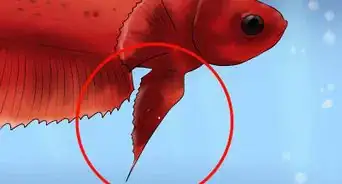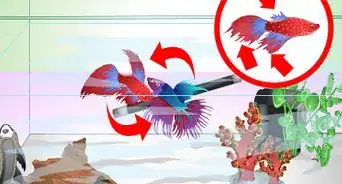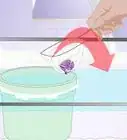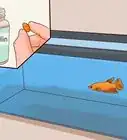This article was co-authored by Deanne Pawlisch, CVT, MA. Deanne Pawlisch is a Certified Veterinary Technician, who does corporate training for veterinary practices and has taught at the NAVTA-approved Veterinary Assistant Program at the Harper College in Illinois and in 2011 was elected to the board of the Veterinary Emergency and Critical Care Foundation. Deanne has been a Board Member of the Veterinary Emergency and Critical Care Foundation in San Antonio, Texas since 2011. She holds a BS in Anthropology from Loyola University and an MA in Anthropology from Northern Illinois University.
wikiHow marks an article as reader-approved once it receives enough positive feedback. This article received 29 testimonials and 92% of readers who voted found it helpful, earning it our reader-approved status.
This article has been viewed 449,038 times.
Bettas, otherwise known as Siamese fighting fish, are known for their snazzy colors and flowing fins. Chances are, however, when you brought your betta home in a cup from a pet store, you had no idea how old it was. It is hard to determine exactly how old your betta is, but by using some common sense and observations of your fish, you might be able to make a very close estimate.
Steps
Determining Age with Features
-
1Check your betta's size. Normal adult bettas are usually around 3 inches (7.6 cm) in length. Hold a measuring tape up to your fish's tank and see how long it is. If your betta is less than the average, your betta is most likely a juvenile.[1]
- It can be hard to measure a betta exactly. In most cases, it will be enough to simply get an estimate by holding up a measuring tape against the glass. Be patient since most healthy bettas do not stay still often.
-
2Check your betta's fins. Adult bettas have nice and beautiful flowing fins. If your betta has this characteristic, this is a good sign that it is an adult. If it has tiny fins, then it is either a juvenile or a baby.[2]
- Make sure you know the sex of your betta. Female bettas never get long, flowing fins like the males do.
- Don't confuse normal wear with injuries from diseases.
- Crowntails naturally have 'torn'- looking fins.
Older betta's fins have typically undergone lots of wear and tear. They may have tiny tears or shredded ends.
Advertisement -
3Assess the color of your betta. In general, young bettas are vibrant and middle-aged bettas are slightly faded. The color of the scales of an older betta will be slightly faded and muted.
Note: Bettas that are bred for pets come in a wide variety of colors. However, wild betta fish tend to be grey or dull colored, and only show flashes of color when fighting.[3]
Identifying Signs of Aging
-
1Look for changes in your fish's body. You might notice that with every day, your betta seems to be getting paler or even with daily feeding your fish gets skinnier. These are signs of an aging betta.[4]
Tip: As a betta ages, its back may also begin to arch. An old betta's back is usually humped, while a younger betta's back is more straight. The hump is rounded, so don't confuse this for a sharp spinal problem.
-
2Pay attention to changes in energy. Your betta will flare with much less gusto than it used to when it get old. After so many years, many bettas lose the enthusiasm to flare.
- Also, while a healthy adult betta will swim around vigorously in its tank, old bettas will hide behind plants and décor and swim sluggishly.
- When feeding your betta, watch it to see how quickly it spots its food. Old bettas may swim slowly to their food and miss it a couple of times before spotting it.
-
3Look for cataracts on the betta's eyes. Old bettas tend to have "cataracts," which are filmy or hazy spots inside the eye. This is normal for old bettas, and will happen no matter how big the tank you have is or how clean you keep the water.
Tip: If the fishes' eyes are black and hard to see, that is a sign of a healthy adult betta.[5]
Expert Q&A
-
QuestionMy betta is very active, but he often misses a lot of his food when eating. What does this mean?
 Deanne Pawlisch, CVT, MADeanne Pawlisch is a Certified Veterinary Technician, who does corporate training for veterinary practices and has taught at the NAVTA-approved Veterinary Assistant Program at the Harper College in Illinois and in 2011 was elected to the board of the Veterinary Emergency and Critical Care Foundation. Deanne has been a Board Member of the Veterinary Emergency and Critical Care Foundation in San Antonio, Texas since 2011. She holds a BS in Anthropology from Loyola University and an MA in Anthropology from Northern Illinois University.
Deanne Pawlisch, CVT, MADeanne Pawlisch is a Certified Veterinary Technician, who does corporate training for veterinary practices and has taught at the NAVTA-approved Veterinary Assistant Program at the Harper College in Illinois and in 2011 was elected to the board of the Veterinary Emergency and Critical Care Foundation. Deanne has been a Board Member of the Veterinary Emergency and Critical Care Foundation in San Antonio, Texas since 2011. She holds a BS in Anthropology from Loyola University and an MA in Anthropology from Northern Illinois University.
Certified Veterinary Technician If your betta is eating when you feed him but not consuming all of his food, you may be overfeeding him. Often bettas only require 2-3 pellets per feeding.
If your betta is eating when you feed him but not consuming all of his food, you may be overfeeding him. Often bettas only require 2-3 pellets per feeding. -
QuestionI believe my betta was at least a year old when I got him, as he had fully formed fins and a slight arch in his back. He never made a bubble nest, though. What does this mean about his age?
 Deanne Pawlisch, CVT, MADeanne Pawlisch is a Certified Veterinary Technician, who does corporate training for veterinary practices and has taught at the NAVTA-approved Veterinary Assistant Program at the Harper College in Illinois and in 2011 was elected to the board of the Veterinary Emergency and Critical Care Foundation. Deanne has been a Board Member of the Veterinary Emergency and Critical Care Foundation in San Antonio, Texas since 2011. She holds a BS in Anthropology from Loyola University and an MA in Anthropology from Northern Illinois University.
Deanne Pawlisch, CVT, MADeanne Pawlisch is a Certified Veterinary Technician, who does corporate training for veterinary practices and has taught at the NAVTA-approved Veterinary Assistant Program at the Harper College in Illinois and in 2011 was elected to the board of the Veterinary Emergency and Critical Care Foundation. Deanne has been a Board Member of the Veterinary Emergency and Critical Care Foundation in San Antonio, Texas since 2011. She holds a BS in Anthropology from Loyola University and an MA in Anthropology from Northern Illinois University.
Certified Veterinary Technician You might be correct in your estimate of your betta’s age. Often, tank filtrations systems cause strong currents in your tank that can discourage your fish from making a bubble nest. Bubble nests are part of the breeding process, so if your fish is solitary, it may not build a bubble nest at all.
You might be correct in your estimate of your betta’s age. Often, tank filtrations systems cause strong currents in your tank that can discourage your fish from making a bubble nest. Bubble nests are part of the breeding process, so if your fish is solitary, it may not build a bubble nest at all.
References
About This Article
To tell how old a betta fish is, measure the fish and asses the size of its fins. Adult bettas will usually be around 3 inches long and have long, flowing fins, while juveniles will be smaller with shorter fins. Another way to tell age is by looking at the coloring of the betta. Bettas are vibrant and colorful when young and generally become duller and more faded as they age. You can tell if bettas are old by seeing if they have a humped body or cataracts in their eyes. To learn how to tell the sex of a betta, scroll down!
